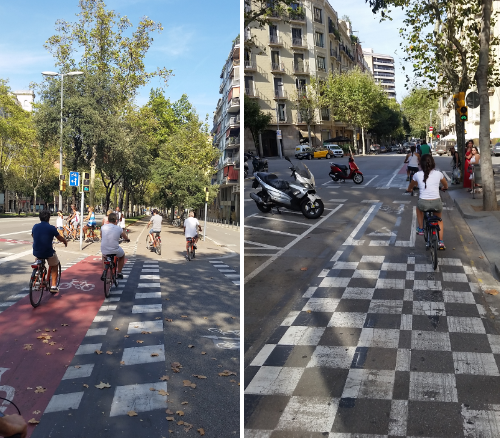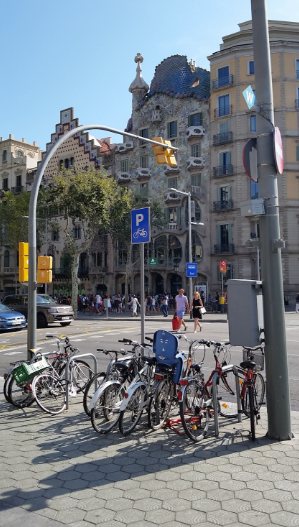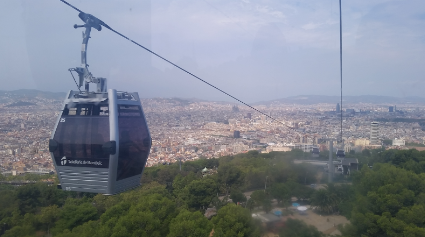How Barcelona gets bicycling right
This summer I spent a few days in Barcelona on vacation. What I found there is a city built for people who ride bikes and car-free tourism that would be welcome here at home.

Bikeshare station with moped parking at Placa de Catalunya. All photos by the author unless otherwise noted.
Bikes are everywhere in Barcelona. Family members who had visited before told me it’s the best way to see the city, so my friends and I rented bikes for two days rather than taking public transit, taxis, or organized bus tours.
Renting the bikes was simple — there are numerous rental shops as well as bike share stations, the latter requiring sign up similar to Capital Bikeshare.
A very popular destination are the city’s picturesque beaches. Riding a bike there, and everywhere, you quickly notice is that there are lots of marked bike lanes that share the road with cars and bikeways that are totally separated and shared only with pedestrians.

Left: A separated bikeway and pedestrian strip. Markings, signal and signs visible. Right: A protected bike lane with marking and bicycle traffic light ahead.
This makes riding a bike feel very safe, which is probably why it is rare to see people wearing helmets. On the beach, the pedestrian and bike path is plenty wide to accommodate everyone, even at the busiest times. Finding a bike rack there as well as everywhere else in the city is also a breeze, with some located right on the boardwalk leading onto the sand.

Bike parking in front of Antonio Gaudi’s Casa Batllo.
At the Arc de Triomf and neighboring Ciutadella Park, wide sidewalks and dedicated bike lanes make getting around easy, fast and safe. In the Gothic District, typically narrow one way streets in the oldest part of town mean that biking and walking are the only fast way to get around.
The only place you have to get off your bike (which is very much worth doing!) is the the famous La Rambla, the main street in the old town. The reason you have to dismount is not cars or buses, but throngs of people. La Rambla is not a pedestrian only mall, like those in many downtowns around the US and world, because it has one lane on each side for car traffic but it has a wide strip in the middle reserved for foot traffic, of which there is plenty.
In the photo below, the car lanes are visible on each side, along with the Metro entrance located at the end of La Rambla. During our visit, we didn’t go into the underground, but Metro stops were plentiful and well-marked.
Nearly seven miles of bike riding made it clear that bike is the best way to get around Barcelona. We encountered some road construction with clearly marked the detours for cyclists and cars alike, showing that both are valued and considered during traffic disruptions. We also saw the Barcelona tram, which made me think about the multiple modes you could easily use in the city.
By bike, you can also get to the Montjuic Castle and the old Olympic Stadium, which are on a hill overlooking the city. Bikeways and connecting bike lanes along the beach make for a quick ride with plenty of sightseeing. Instead of climbing the hill to the castle, you can ride the Teleferic de Montjuic — a gondola operated by the same company that runs the Metro and bus service (fare system is separate for the gondola though).
In this instance, a gondola seemed like the perfect mode to take you to the top and back quickly and efficiently. It also gives riders an amazing panoramic view of the city and a cyclist time to rest the legs.
On the way to return our rentals we enjoyed more sights and sounds of the city. At this point, you notice that most car traffic was fairly confined to a few large boulevards, and in those places room is almost always reserved on the side or in the middle for bikeways and walkways. The central gathering places for people almost always seem to be planned around bikes and pedestrians, with cars being an afterthought.
In Barcelona, it was obvious that planning for bike riders, giving wide sidewalks to pedestrians, and connecting all those facilities with well marked and signaled infrastructure encouraged people to use those modes. Combining that with mass transit like a subway, light rail, or buses (even gondola, where it’s useful!) can get people moving effectively and create more livable and beautiful city landscapes.
In a lot of our region’s densely-populated areas already have bike lanes, but there isn’t always separation from car traffic. And that’s what makes the biggest difference. In Barcelona, it feels as though all but the busiest streets are for bikes and people rather than just cars.




